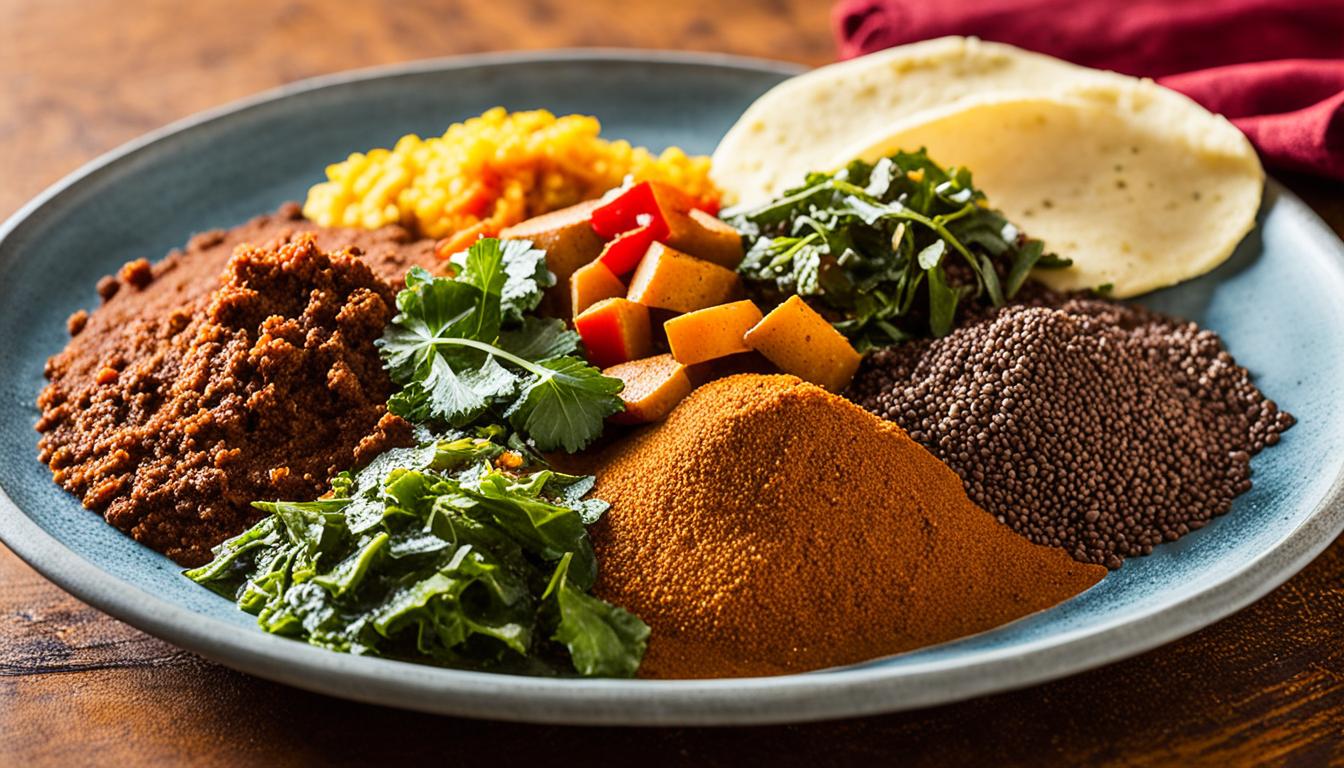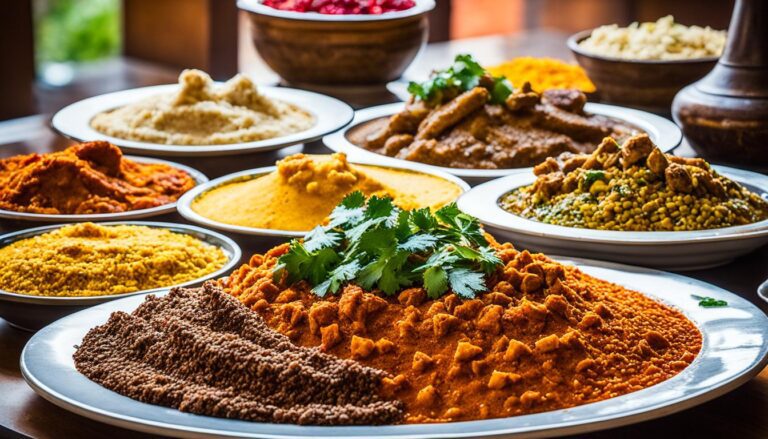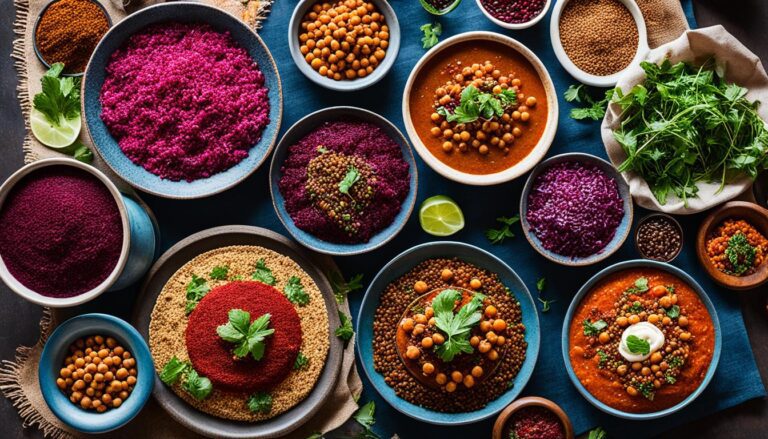What Is Ethiopian Food Consist Of?
When you think of Ethiopian cuisine, what comes to mind? Perhaps you envision exotic spices, communal dining, or unique flavors. But have you ever wondered what exactly Ethiopian food consists of? What makes it so special and different from other culinary traditions?
Well, get ready to tantalize your taste buds and expand your culinary horizons as we delve into the world of Ethiopian cuisine. From the staple ingredient that forms the foundation of every meal to the mouthwatering vegetarian options and the flavorful spices that bring it all together, Ethiopian food is a gastronomic experience like no other.
Key Takeaways:
- Ethiopian cuisine is known for its unique flavors and communal dining experience.
- Injera, a fermented pancake made from teff flour, is the staple of Ethiopian food.
- Spicy stews and vegetarian dishes are popular components of Ethiopian meals.
- Ethiopian cuisine is seasoned with spices like berbere, mitmita, and awaze.
- Vegetarian options, such as shiro wat and misir wat, are widely available in Ethiopian cuisine.
Injera: The Staple of Ethiopian Food
Injera is the staple and most widely consumed element of Ethiopian cuisine. It is made from teff, a grain ground into flour and fermented to create a batter, which is then cooked into a large, circular pancake. Injera serves as the foundation of Ethiopian food and is automatically served with any dish ordered at an Ethiopian restaurant.
It is typically served on a communal platter called a gebeta, with various stews, curries, and vegetables placed on top of the injera. Injera is torn into pieces and used to scoop up bites of food, providing a unique and enjoyable dining experience.
Flavors and Seasonings of Ethiopian Food
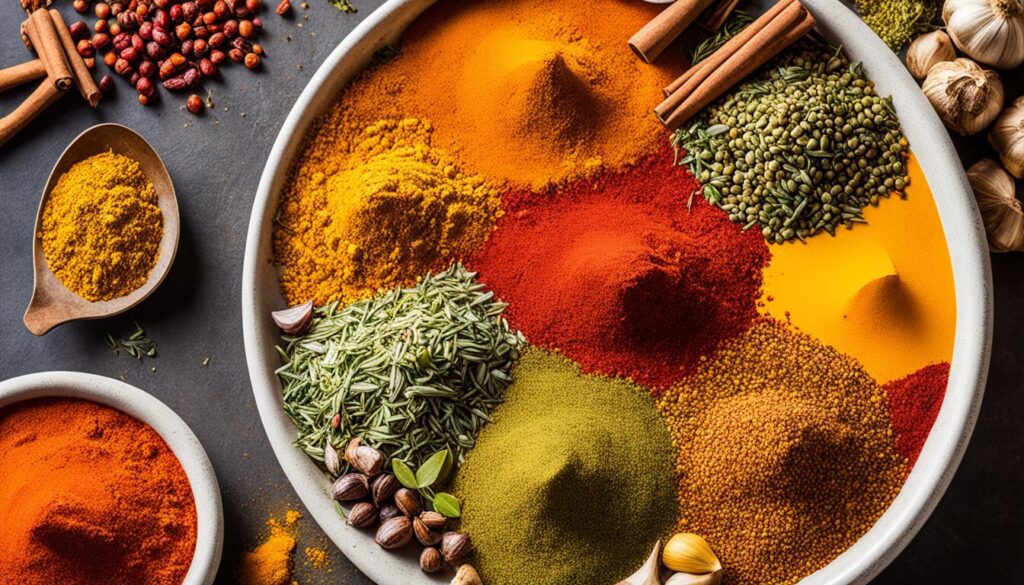
Ethiopian food is known for its distinct flavors and seasonings that make it a truly unique and memorable culinary experience. The use of diverse spices and seasonings contributes to the rich and well-seasoned nature of Ethiopian cuisine.
Berbere: The Soul of Ethiopian Cuisine
The most common spice blend in Ethiopian cuisine is berbere. This flavorful blend typically consists of chili powder, fenugreek, ginger, garlic, cardamom, cinnamon, and other aromatic spices. Berbere adds a spicy and aromatic kick to Ethiopian dishes, infusing them with layers of complex flavors.
Mitmita: A Salty and Spicy Seasoning
Alongside berbere, mitmita is another commonly used seasoning in Ethiopian cuisine. This blend is known for its fiery heat and salty taste, making it a perfect addition to meat dishes. Mitmita adds an intense burst of flavor that tantalizes the taste buds and enhances the overall dining experience.
Awaze: A Flavorful Paste for Meat Dishes
Awaze is a paste variation of berbere mixed with oil and Ethiopian wine or whiskey. It is often served alongside meat dishes, adding depth and complexity to the flavors. Awaze adds a slightly tangy and spicy element to the dishes, creating a harmonious balance of flavors that perfectly complement the richness of the meat.
Niter Kibbeh: Ethiopian Butter Infused with Spices
A key ingredient in Ethiopian cuisine is niter kibbeh, also known as Ethiopian butter. This clarified butter is brewed with an array of spices such as fenugreek, cumin, and turmeric, resulting in a fragrant and flavorful concoction. Niter kibbeh adds a luscious and aromatic element to dishes, enhancing their overall taste and texture.
The combination of berbere, mitmita, awaze, and niter kibbeh, among other seasonings, creates the unique flavor profile that is characteristic of Ethiopian cuisine. Whether you’re enjoying a spicy stew or savoring a vegetarian dish, these seasonings are essential in creating a culinary experience that excites the senses and leaves a lasting impression.
Vegetarian Options in Ethiopian Cuisine
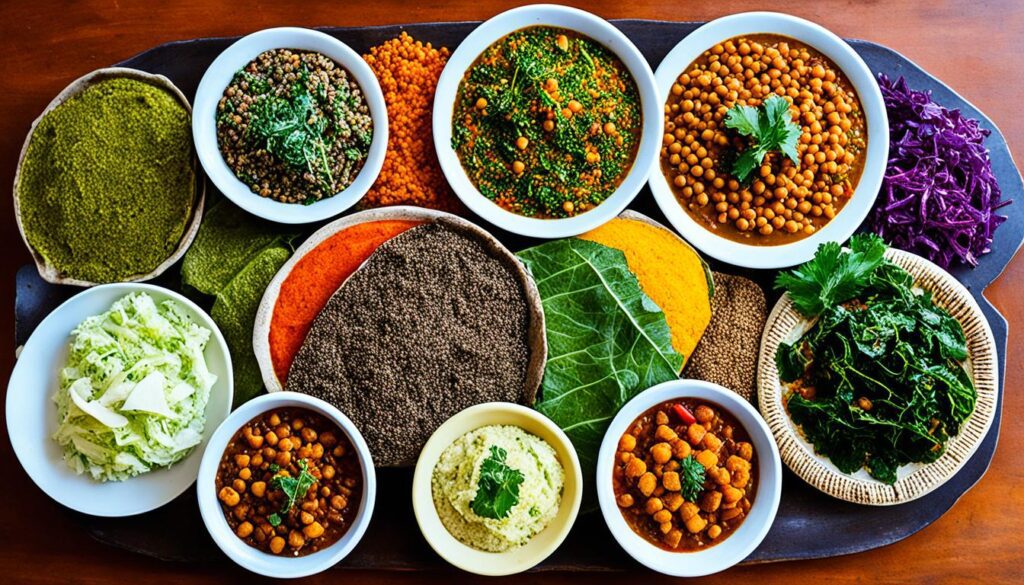
Ethiopia offers a variety of delicious vegetarian options in its cuisine. Whether you follow a vegetarian diet or simply enjoy exploring plant-based dishes, Ethiopian cuisine has something to satisfy your palate. There are numerous vegetarian options available, particularly on fasting days and throughout the week. These dishes capture the essence of traditional Ethiopian flavors while offering a satisfying and nutritious dining experience.
One popular choice for vegetarians is shiro wat, a delectable dish made from chickpea and broad bean flour. It is often included in mixed combination platters, where it shines as the centerpiece of the meal. The creamy and flavorful shiro wat pairs perfectly with injera, the traditional Ethiopian bread made from fermented teff flour. The combination of shiro wat and injera creates a delightful balance of flavors and textures.
Another staple for vegetarians is misir wat, a red lentil stew cooked with berbere spice powder for added depth and complexity. The berbere spice blend, consisting of chili powder, ginger, garlic, and other aromatic ingredients, infuses the dish with a rich and robust flavor profile. The tender lentils in misir wat provide a satisfying protein source, making it a nutritious and filling option for vegetarians.
If you’re craving something fresh and vibrant, you’ll enjoy salata, or Ethiopian salad. This refreshing dish is made with a combination of fresh tomatoes, onions, chilies, and herbs, dressed with a tangy blend of lemon juice and olive oil. Salata adds a burst of freshness to your meal and complements the bold flavors of other Ethiopian dishes.
Vegetarian Ethiopian food offers a diverse and satisfying dining experience for all. The combination of flavors, textures, and spices creates a harmonious balance that is sure to tantalize your taste buds. Whether you’re seeking a traditional injera and shiro wat combination or exploring the vibrant flavors of misir wat and salata, Ethiopian cuisine has something to offer every vegetarian food enthusiast.
Conclusion
Ethiopian cuisine offers a vibrant and exciting culinary experience that is sure to delight food enthusiasts. With its unique flavors and communal dining tradition, Ethiopian food brings people together through a shared love for good food and good company.
At the heart of Ethiopian cuisine is injera, a versatile and delicious pancake made from teff flour. This staple serves as a foundation for a variety of stews and vegetable dishes, providing a delightful combination of taste and texture.
The flavors of Ethiopian cuisine are further enhanced by the use of spices like berbere, mitmita, and awaze. These aromatic blends infuse the dishes with a tantalizing and unforgettable taste. Additionally, niter kibbeh – Ethiopian butter brewed with spices – adds richness and depth to the flavors.
For those seeking vegetarian options, Ethiopian cuisine is a haven. From mouthwatering dishes like shiro wat made from chickpea and broad bean flour, to hearty misir wat, a red lentil stew, there are plenty of delicious choices. Ethiopian salad, known as salata, is a refreshing and vibrant dish that provides a delightful contrast to the spicier options.
Whether you choose to dine in an Ethiopian restaurant or try your hand at cooking Ethiopian recipes at home, the unique flavors and communal dining experience of Ethiopian cuisine are sure to leave a lasting impression. So, gather your loved ones and embark on a culinary adventure with Ethiopian cuisine – a feast for all the senses.

